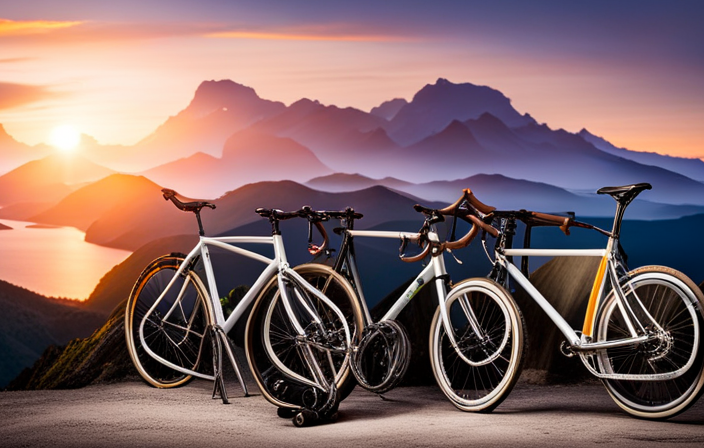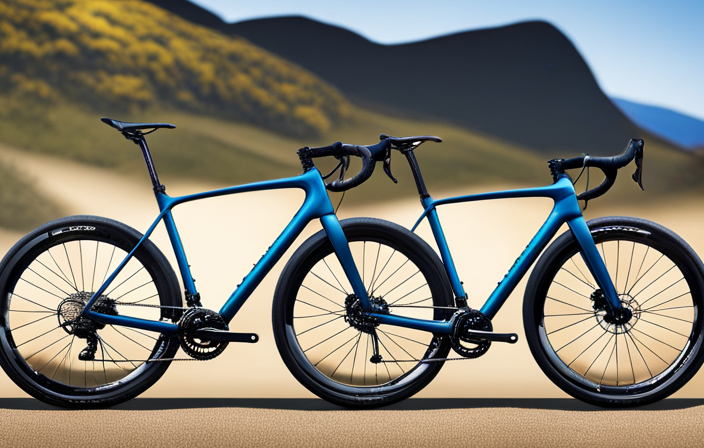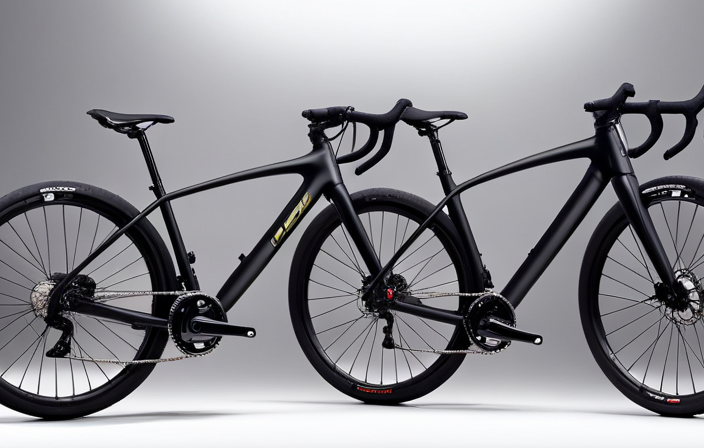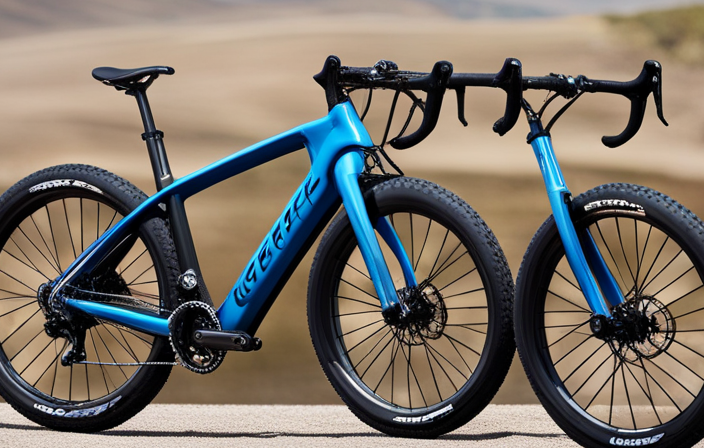Are you considering going off-road, but can’t decide between a cross bike and a gravel bike? Do not worry, as I am here to explain the distinctions and help you make a knowledgeable choice.
These two mighty machines may appear similar at first glance, but their nuances lie within their purpose, frame design, tire clearance, brakes, versatility, cost, popularity, and personal preference.
So buckle up and prepare to embark on a journey of discovery as we unravel the mysteries of these off-road companions.
Key Takeaways
- Cross bikes are designed for cyclocross racing with aggressive geometry and narrower tires, while gravel bikes are designed for long rides on mixed terrain with relaxed geometry and wider tire clearance.
- Gravel bikes prioritize durability over weight savings and have longer wheelbases for comfort, while cross bikes have narrower tire clearance and narrower range of gears.
- Gravel bikes can accommodate wider tires, providing better traction and control, while cross bikes are designed for smoother surfaces and have narrower tire clearances.
- Cross bikes are equipped with cantilever brakes for lightweight and mud clearance, while gravel bikes often feature disc brakes for superior braking performance across terrains and weather conditions.
Purpose and Terrain
The main difference between a cross bike and a gravel bike lies in their intended purpose and the type of terrain they are designed for. While both bikes are versatile and can handle a variety of off-road conditions, they have some key distinctions.
Cross bikes, also known as cyclocross bikes, are primarily built for cyclocross racing. This demanding sport involves riding through mud, grass, sand, and even stairs. As such, cross bikes are designed with aggressive geometry that allows for quick acceleration and nimble handling. They typically have narrower tires with more aggressive tread patterns to provide better traction on loose surfaces. Additionally, cross bikes often feature higher bottom brackets to avoid pedal strikes during sharp turns.
On the other hand, gravel bikes are specifically designed for long rides over mixed terrain such as dirt roads or gravel paths. They prioritize comfort and stability over agility. Gravel bikes usually feature more relaxed geometry with a longer wheelbase and slacker head tube angles for added stability on rough surfaces. They also come equipped with wider tires that offer increased grip and improved shock absorption.
When it comes to riding techniques and maintenance tips, both cross bikes and gravel bikes require similar skills and care. However, due to the nature of cyclocross racing, cross bike riders need to focus on mastering dismounts/remounts as well as shouldering techniques for overcoming obstacles efficiently.
Moving into the next section about frame design and geometry, it is important to consider how these factors contribute to the overall performance of these two types of bicycles without compromising their specific purposes.
Frame Design and Geometry
When it comes to frame design and geometry, you’ll notice distinct variations between a cross bike and a gravel bike. These differences play a crucial role in determining the bike’s performance and suitability for different riding conditions. Here are three key aspects to consider:
-
Saddle comfort: Gravel bikes typically have a more relaxed geometry compared to cross bikes. This means they have a longer wheelbase, taller head tube, and shorter top tube, resulting in a more upright riding position. This design promotes greater comfort during long rides by reducing strain on your lower back.
-
Frame material: Both cross bikes and gravel bikes can be made from various materials like aluminum, carbon fiber, or steel. However, gravel bikes often prioritize durability over weight savings due to their intended use on rough terrain. As a result, you may find many gravel bikes constructed from steel frames that offer excellent strength and resilience.
-
Tire clearance: Gravel bikes are designed to accommodate wider tires compared to cross bikes. This allows riders to tackle different surfaces and terrains, from gravel roads to muddy trails. The increased tire clearance provides better traction, stability, and control, enhancing the bike’s versatility and performance.
These three aspects highlight the distinct characteristics of gravel bikes and how they differ from cross bikes. By understanding these differences, you can make an informed decision when choosing the right bike for your riding preferences and needs.
Tire Clearance
To determine if a bike is suitable for your riding conditions, consider the tire clearance. When comparing gravel bikes vs cross bikes, one key difference lies in the amount of tire width they can accommodate. Gravel bikes typically have more generous tire clearance than cross bikes, allowing riders to use wider tires. This is because gravel biking often involves rougher terrains and off-road adventures where wider tires provide better traction and stability.
Gravel bikes usually have enough room to fit tires ranging from 35mm to 45mm in width, or sometimes even wider. On the other hand, cross bikes are designed for cyclocross racing which mostly takes place on smoother surfaces like grass, dirt, or pavement. As a result, they tend to have narrower tire clearances compared to gravel bikes.
Having wider tires on a gravel bike allows riders to tackle various types of terrain with confidence while still maintaining a comfortable ride. It also enhances their ability to handle obstacles such as loose rocks or sandy paths without losing control.
Next, let’s delve into the importance of tire type when it comes to choosing between a gravel bike and a cross bike.
Tire Type
Consider the type of tires that best suit your riding needs and preferences.
When it comes to tire type, both cross bikes and gravel bikes offer a variety of options. For off-road adventures and rough terrains, wider and knobbier tires are recommended. These provide better traction and stability, allowing you to tackle challenging surfaces with confidence.
On the other hand, if you mostly ride on smoother surfaces or paved roads, narrower tires with minimal tread patterns would be more suitable. These tires offer lower rolling resistance and increased speed.
Gravel bikes typically come equipped with wider tire clearances compared to cross bikes, allowing for even larger tires to be fitted. This allows for greater versatility when choosing tire types. You can opt for wider tires with aggressive tread patterns for improved grip in muddy or loose conditions. Alternatively, if you prefer a faster ride on gravel or hard-packed dirt trails, you can choose narrower slick or semi-slick tires.
Considering your riding style and terrain preferences is crucial when selecting the right tire type for your bike. Once you have determined what works best for you in terms of tire clearance and type, it’s time to move on to the next important aspect: brakes.
Brakes
If you want to ensure your safety and control on the road, it’s important to have reliable brakes on your bike. When comparing cross bikes and gravel bikes, one key difference lies in their brake types and braking performance.
Cross bikes typically come equipped with cantilever brakes, while gravel bikes often feature disc brakes. Cantilever brakes are a common choice for cross bikes due to their lightweight design and mud clearance. They work by using a cable system that pulls on the brake arms, which then squeeze the brake pads against the rim of the wheel. While they provide decent stopping power, especially in dry conditions, cantilever brakes can be less effective in wet or muddy environments.
On the other hand, gravel bikes usually come with disc brakes which offer superior braking performance across various terrains and weather conditions. Disc brakes utilize a rotor attached to the wheel hub, along with calipers that clamp down on it when you apply pressure to the brake lever. This design provides consistent stopping power and better modulation regardless of whether you’re riding through rain-soaked roads or tackling steep descents.
Transitioning into the subsequent section about gearing: Now that we’ve covered braking performance…
Gearing
Now that we’ve covered the different types of brakes on cross bikes and gravel bikes, let’s dive into the world of gearing. Gearing plays a crucial role in determining the efficiency and performance of a bike, whether it’s conquering steep climbs or powering through flat terrain.
One key difference between cross bikes and gravel bikes is their gear ratio options. Cross bikes typically have a narrower range of gears compared to gravel bikes. This allows for quick acceleration and efficient pedaling during cyclocross races where speed is essential. On the other hand, gravel bikes offer a wider range of gears to tackle various terrains encountered during off-road adventures. The lower gears provide easier climbing options, while higher gears facilitate faster speeds on flat surfaces.
Having access to a wide range of gear ratios ensures that riders can maintain an optimal cadence regardless of the terrain they are riding on, resulting in improved efficiency and reduced fatigue.
Now that we understand how gearing affects performance, let’s move on to another important aspect: accessories and mounting points.
Accessories and Mounting Points
Accessories and mounting points are crucial for enhancing the functionality and versatility of your ride. When it comes to cross bikes and gravel bikes, they both offer various options for attaching accessories and gear. However, there are some differences to consider.
One key difference is in the bikepacking setup. Gravel bikes often come with more mounting points on the frame and fork, allowing for easy installation of racks, panniers, or frame bags. This makes them well-suited for carrying camping equipment or other bulky items needed for longer adventures.
On the other hand, cross bikes typically have fewer mounting points, as they are primarily designed for racing purposes where weight is a concern. While you can still attach some accessories like bottle cages or small bags, they may not be as suitable for extensive bikepacking trips.
Another aspect to consider is fender compatibility. Gravel bikes usually have clearance for wider tires and fenders, making them ideal for riding in muddy or wet conditions. Cross bikes, however, may not have sufficient clearance to accommodate fenders without compromising tire clearance.
In conclusion, when it comes to accessories and mounting points, gravel bikes tend to offer more options for bikepacking setups and fender compatibility compared to cross bikes. Now let’s explore another important aspect: weight reduction strategies.
Weight
When it comes to weight, you’ll want to consider strategies for reducing the overall load on your bike. The weight of a bike can greatly affect its performance and handling characteristics. One factor that contributes to the weight of a bike is the frame material.
Cross bikes and gravel bikes often have different frame materials, which can impact their weight. Cross bikes typically have frames made from aluminum or carbon fiber, both of which are lightweight materials that offer excellent strength and stiffness. Gravel bikes, on the other hand, may feature steel frames, which are heavier but provide a smoother ride quality.
Reducing weight can improve the agility and responsiveness of your bike. One way to do this is by choosing a cross or gravel bike with a lighter frame material like carbon fiber. Additionally, you can opt for lighter components such as wheels and handlebars. Another strategy is to carefully select accessories that add minimal weight but still provide functionality.
Next up, let’s talk about handlebars and how they differ between cross bikes and gravel bikes…
Handlebars
To improve your riding experience, consider the handlebars on your bike. The choice of handlebar materials and shapes can greatly affect your control and comfort while riding.
Handlebars are typically made from aluminum, carbon fiber, or steel. Aluminum handlebars are lightweight and durable, making them a popular choice for many riders. Carbon fiber handlebars offer even greater weight savings and absorb road vibrations for a smoother ride. Steel handlebars are heavier but provide excellent strength and durability.
In addition to material, handlebar shape plays a crucial role in determining your riding position and handling characteristics. Drop bars are commonly found on cross bikes and offer multiple hand positions for long rides on pavement or smooth dirt roads. They provide an aerodynamic position for speed and efficiency.
On the other hand, gravel bikes often feature flared drop bars that offer more control when navigating technical off-road terrain. The wider grip allows for better stability during descents or rough sections of gravel trails.
Transitioning into the next section about suspension without using the word ‘step,’ it is important to also consider the role of suspension in enhancing your overall riding experience.
Suspension
Suspension is an important consideration when comparing cross bikes and gravel bikes. Cross bikes are typically designed for racing, so they have no suspension in order to maximize power transfer efficiency.
On the other hand, gravel bikes may feature front suspension or a more relaxed frame design to enhance comfort on rough terrains. The presence or absence of suspension greatly affects the overall performance and ride experience of these two types of bikes.
Cross bike typically has no suspension for efficient power transfer in races
A cross bike usually lacks suspension, allowing for efficient power transfer during races. This is achieved by focusing on frame materials and wheel size. Cross bikes typically have a lightweight frame made from materials like aluminum or carbon fiber, which helps to maximize power transfer from the rider’s pedal strokes to the wheels. Additionally, they usually feature larger 700c wheels with narrower tires, providing less rolling resistance and better handling on smooth surfaces.
-
Frame Materials:
-
Lightweight aluminum or carbon fiber frames
-
Stiff construction for optimal power transfer
-
Wheel Size:
-
Larger 700c wheels
-
Narrower tires for reduced rolling resistance
Transitioning into the subsequent section, a gravel bike may have front suspension or a more relaxed frame design for improved comfort on rough terrains.
Gravel bike may have front suspension or a more relaxed frame design for improved comfort on rough terrains
Gravel bikes often feature front suspension or a more relaxed frame design, providing increased comfort on rough terrains. This is achieved through the use of different frame materials, such as carbon fiber or aluminum, that absorb vibrations and impacts from uneven surfaces. Additionally, the handlebar options on a gravel bike are designed to enhance control and stability in off-road conditions.
The frame material used in gravel bikes is typically chosen for its lightweight and durable properties. Carbon fiber frames offer excellent strength-to-weight ratio, while aluminum frames provide affordability without compromising strength. These materials contribute to the overall comfort of the bike by reducing fatigue caused by excessive vibrations.
When it comes to handlebars, gravel bikes offer various options to cater to different riding styles. Drop bars are commonly found on gravel bikes, allowing riders to adopt an aerodynamic position during fast-paced rides on smooth surfaces. However, some models also come with flat or flared handlebars for improved maneuverability and control when tackling technical terrains.
With these features in mind, let’s now delve into the next section about ‘riding style’ and explore how it differs between cross bikes and gravel bikes.
Riding Style
When you ride a cross bike, your riding style is more aggressive and focused on speed. The design of a cross bike allows for quick acceleration and nimble maneuverability, making it ideal for racing and competitive cycling. To maximize performance on a cross bike, riders employ specific riding techniques and training methods.
Here are three key aspects of the riding style on a cross bike:
-
Body Positioning: When riding a cross bike, you want to maintain an aerodynamic position by bending your elbows, lowering your torso, and keeping your weight forward. This helps to reduce wind resistance and increase speed.
-
Cornering Techniques: Cross bikes excel at taking tight turns at high speeds due to their responsive handling capabilities. By leaning into the turn while maintaining control over the front wheel, riders can navigate corners efficiently without losing momentum.
-
Power Transfer: To optimize power transfer from pedal strokes to forward motion, cross cyclists use specialized training methods such as interval training and hill repeats. These techniques improve strength and endurance for sustained bursts of speed during races.
The versatility of both cross bikes and gravel bikes lies in their ability to handle various terrains with ease.
Versatility
When it comes to versatility, the difference between a cross bike and a gravel bike becomes quite evident.
As someone who is familiar with these types of bikes, I can confidently say that a cross bike is primarily designed for racing and may not perform well on non-cyclocross terrains.
On the other hand, a gravel bike is built to handle a wide range of terrains, including pavement, gravel, and dirt trails. This makes it a much more versatile option for those looking to explore different types of cycling adventures.
Cross bike primarily designed for racing and may not perform well on non-cyclocross terrains
If you’re looking for a bike that is primarily designed for racing, a cross bike may not perform well on non-cyclocross terrains. Cross bikes are typically built with a lightweight frame material, such as aluminum or carbon fiber, to maximize speed and agility on the racecourse. However, this design choice can make them less suitable for rougher terrains like gravel or dirt trails.
Additionally, cross bikes usually come with smaller wheel sizes, typically 700c, which are optimized for quick acceleration and maneuverability in cyclocross races. These smaller wheels may struggle to navigate through uneven surfaces or provide a smooth ride on longer distances.
On the other hand, a gravel bike can handle a wide range of terrains, including pavement, gravel, and dirt trails. This versatility makes them ideal for riders who enjoy exploring various types of landscapes without compromising performance.
Gravel bike can handle a wide range of terrains, including pavement, gravel, and dirt trails
While a cross bike is primarily designed for racing and may not perform well on non-cyclocross terrains, a gravel bike is versatile and can handle a wide range of terrains. With its capability to tackle pavement, gravel, and dirt trails, the gravel bike offers a more diverse riding experience.
Here are four key differences between a gravel bike and other types of bikes:
-
Gravel Bike vs Mountain Bike: While both can handle off-road terrains, mountain bikes are better suited for technical trails with steep inclines and obstacles, whereas gravel bikes excel in long-distance endurance rides.
-
Cross Bike vs Road Bike: Cross bikes are built for cyclocross races with features like wider tire clearance and disc brakes, while road bikes prioritize speed and aerodynamics.
-
Versatility: Gravel bikes offer the best of both worlds by combining elements from road bikes and mountain bikes, making them suitable for various terrains.
-
Comfort: Gravel bikes typically have more relaxed geometry compared to road or cross bikes, providing a more comfortable riding position.
Now let’s explore the next aspect: cost.
Cost
The cost of a cross bike and a gravel bike is typically higher than that of a regular road bike. This is mainly due to the specialized components and features these bikes possess, designed to enhance their performance in off-road conditions. When comparing the cost of both types of bikes, it is important to consider the performance difference as well.
Cross bikes are specifically built for cyclocross racing, which requires agility, speed, and maneuverability on various terrains. As a result, cross bikes often come with lightweight frames, carbon fiber components, and high-end drivetrains, making them more expensive than standard road bikes.
On the other hand, gravel bikes are designed for versatility and endurance over long distances on mixed surfaces. They typically have more relaxed geometry compared to cross bikes and prioritize comfort during longer rides. Gravel bikes may not have the same level of top-end performance as cross bikes but they excel in offering stability and durability across different terrains. Because of their wider tire clearance and more robust construction, gravel bikes tend to be slightly cheaper than cross bikes.
With an understanding of the cost comparison between cross bikes and gravel bikes established, it’s also worth considering their popularity and availability in today’s cycling market…
Popularity and Availability
Popularity and availability of these bikes vary greatly in the cycling market. The demand for cross bikes tends to be higher in certain regions, such as Europe and North America, where cyclocross racing is more popular. This popularity translates into a wider range of options from various brands, making it easier for consumers to find a cross bike that suits their needs.
Gravel bikes, on the other hand, have gained significant popularity in recent years due to their versatility and ability to handle a variety of terrains. This has led to an increase in availability worldwide, with many major bike manufacturers now offering dedicated gravel bike models.
When it comes to specific brands, both cross bikes and gravel bikes are offered by well-known companies like Specialized, Trek, Giant, and Cannondale. However, there are also smaller boutique brands that cater specifically to either cross or gravel enthusiasts. These niche brands often offer unique features and customization options that may not be available from larger manufacturers.
Transitioning into the subsequent section about personal preference: Ultimately, the popularity and availability of these bikes should be considered alongside personal preferences when deciding between a cross bike and a gravel bike.
Personal Preference
Ultimately, it all comes down to what I prefer when choosing between a cross bike and a gravel bike. When it comes to riding technique, both bikes have their advantages.
A cross bike is designed for racing on varied terrains, with a more aggressive geometry that allows for quick handling and maneuverability. This makes it ideal for navigating tight corners and tackling steep descents.
On the other hand, a gravel bike is built for long-distance endurance rides on gravel roads and rough trails. It has a more relaxed geometry that provides stability and comfort over long hours in the saddle.
Bike fit is another important consideration. A cross bike typically has a more upright position, which can be beneficial for riders who prioritize visibility and control. However, this may not be as comfortable for longer rides or riders with back problems.
On the other hand, a gravel bike offers a more relaxed riding position that reduces strain on the back and neck. This can be advantageous during long rides or multi-day adventures.
In conclusion, when choosing between a cross bike and a gravel bike, personal preference plays an essential role in determining which one suits me best. By considering my riding technique needs and finding the right bike fit, I can ensure an enjoyable cycling experience regardless of whether I choose a cross or gravel bike.
Frequently Asked Questions
Can I use a gravel bike for road biking as well?
Yes, you can definitely use a gravel bike for road biking. Gravel bikes are versatile and designed to handle various terrains, including pavement.
The pros of using a gravel bike on the road are that they provide a comfortable riding position, often have wider tires for added stability, and can accommodate racks and fenders for commuting or touring.
However, some cons include slightly slower speeds compared to dedicated road bikes and less aerodynamic positioning.
What is the maximum weight capacity of a cross bike?
The maximum weight capacity of a cross bike refers to the amount of load it can handle without compromising performance. Cross bikes are typically designed for agility and speed, rather than heavy loads. While specific weight capacities may vary depending on the model and brand, cross bikes generally have lower weight capacities compared to touring or cargo bikes.
If you require a bike suitable for heavy loads, it is recommended to consider other types of bicycles specifically designed for that purpose.
Are gravel bikes suitable for long-distance touring?
When it comes to long-distance touring, gravel bikes are an excellent choice. They offer a multitude of advantages such as their versatility and durability on various terrains.
To ensure a successful tour, it is crucial to have the recommended gear. This includes reliable panniers or bikepacking bags, lightweight camping equipment, and comfortable clothing suitable for changing weather conditions.
With these essentials in place, your gravel bike will be the perfect companion for unforgettable adventures.
Can I convert a cross bike into a gravel bike by changing the tires?
Yes, you can convert a cross bike into a gravel bike by changing the tires. Gravel bike tires are wider and have more tread than traditional cross bike tires. This allows for better traction and stability on rougher terrain.
By swapping out your cross bike’s narrower, smoother tires for wider, knobby ones designed for gravel riding, you can enhance your bike’s performance in off-road conditions and enjoy the benefits of a dedicated gravel bike without purchasing a new one.
Do cross bikes and gravel bikes have different frame materials?
Cross bikes and gravel bikes typically have similar frame materials. Both types of bikes are designed for off-road riding, so they require a durable and lightweight frame. Common frame materials used in cross and gravel bikes include aluminum, carbon fiber, and steel. These materials offer the necessary strength to handle rough terrains while still being light enough for efficient pedaling.
Ultimately, the choice of frame material depends on personal preferences and budget constraints.
Conclusion
In conclusion, the difference between a cross bike and a gravel bike lies in their purpose, design, and versatility.
While both bikes are designed for off-road riding, cross bikes are built specifically for racing on cyclocross courses with their aggressive geometry and narrower tire clearance.
On the other hand, gravel bikes are more versatile with a more relaxed frame geometry and wider tire clearance to handle various terrains.
It’s interesting to note that according to recent statistics, the popularity of gravel bikes has been steadily increasing, with sales rising by 30% in the past year alone.









